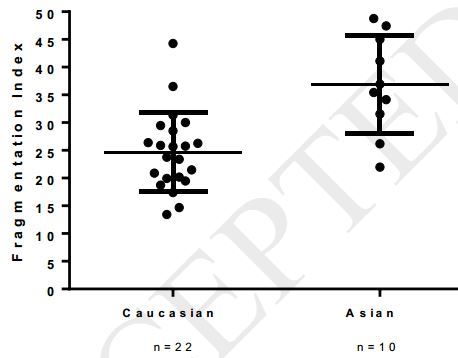Sleep fragmentation 2X worse in UK senior women having dark skins
25-hydroxyvitamin D status, light exposure and sleep quality in UK dwelling South Asian and Caucasian postmenopausal women.
J Steroid Biochem Mol Biol. 2019 Jan 30. pii: S0960-0760(18)30385-6. doi: 10.1016/j.jsbmb.2019.01.020.
Darling AL1, Hart KH2, Arber S3, Berry JL4, Morgan PL5, Middleton BA5, Lanham-New S2, Skene DJ6.
📄 Download the PDF from Sci-Hub via VitaminDWiki

There is a lack of research into 25-hydroxyvitamin D (25(OH)D) status, light exposure and sleep patterns in South Asian populations. In addition, results of research studies are conflicting as to whether there is an association between 25(OH)D status and sleep quality. We investigated 25(OH)D status, self-reported and actigraphic sleep quality in n = 35 UK dwelling postmenopausal women (n = 13 South Asians, n = 22 Caucasians), who kept daily sleep diaries and wore wrist-worn actiwatch (AWL-L) devices for 14 days. A subset of n = 27 women (n = 11 South Asian and n = 16 Caucasian) also wore a neck-worn AWL-L device to measure their light exposure. For 25(OH)D concentration, South Asians had a median ± IQR of 43.8 ± 28.2 nmol/L, which was significantly lower than Caucasians (68.7 ± 37.4 nmol/L)(P = 0.001).
Similarly, there was a higher sleep fragmentation in the South Asians (mean ± SD 36.9 ± 8.9) compared with the Caucasians (24.7 ± 7.1)(P = 0.002). Non-parametric circadian rhythm analysis of rest/activity patterns showed a higher night-time activity (L5) (22.6 ± 14.0 vs. 10.5 ± 4.4; P = 0.0008) and lower relative amplitude (0.85 ± 0.07 vs. 0.94 ± 0.02; P < 0.0001) in the South Asian compared with the Caucasian women. More South Asians (50%) met the criteria for sleep disorders (PSQI score >5) than did Caucasians (27%) (P = 0.001, Fishers Exact Test). However, there was no association between 25(OH)D concentration and any sleep parameter measured (P > 0.05) in either ethnic group. South Asians spent significantly less time in illuminance levels over 200 lux (P = 0.009) than did Caucasians. Overall, our results show that postmenopausal South Asian women have lower 25(OH)D concentration than Caucasian women. They also have higher sleep fragmentation, as well as a lower light exposure across the day. This may have detrimental implications for their general health and further research into sleep quality and light exposure in the South Asian ethnic group is warranted.
